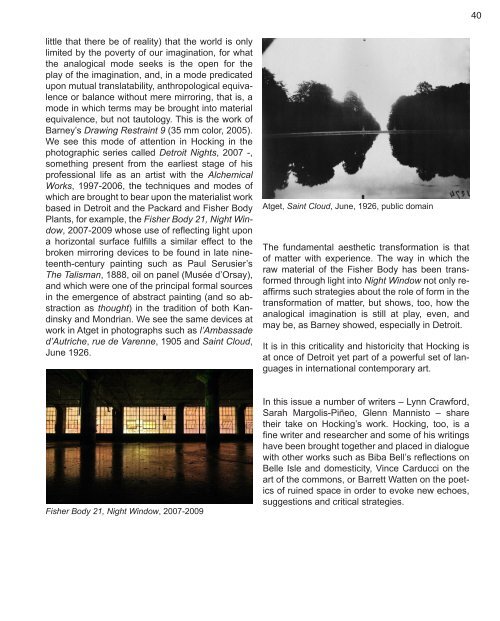Detroit Research Volume 1
You also want an ePaper? Increase the reach of your titles
YUMPU automatically turns print PDFs into web optimized ePapers that Google loves.
40<br />
little that there be of reality) that the world is only<br />
limited by the poverty of our imagination, for what<br />
the analogical mode seeks is the open for the<br />
play of the imagination, and, in a mode predicated<br />
upon mutual translatability, anthropological equivalence<br />
or balance without mere mirroring, that is, a<br />
mode in which terms may be brought into material<br />
equivalence, but not tautology. This is the work of<br />
Barney’s Drawing Restraint 9 (35 mm color, 2005).<br />
We see this mode of attention in Hocking in the<br />
photographic series called <strong>Detroit</strong> Nights, 2007 -,<br />
something present from the earliest stage of his<br />
professional life as an artist with the Alchemical<br />
Works, 1997-2006, the techniques and modes of<br />
which are brought to bear upon the materialist work<br />
based in <strong>Detroit</strong> and the Packard and Fisher Body<br />
Plants, for example, the Fisher Body 21, Night Window,<br />
2007-2009 whose use of reflecting light upon<br />
a horizontal surface fulfills a similar effect to the<br />
broken mirroring devices to be found in late nineteenth-century<br />
painting such as Paul Serusier’s<br />
The Talisman, 1888, oil on panel (Musée d’Orsay),<br />
and which were one of the principal formal sources<br />
in the emergence of abstract painting (and so abstraction<br />
as thought) in the tradition of both Kandinsky<br />
and Mondrian. We see the same devices at<br />
work in Atget in photographs such as l’Ambassade<br />
d’Autriche, rue de Varenne, 1905 and Saint Cloud,<br />
June 1926.<br />
Atget, Saint Cloud, June, 1926, public domain<br />
The fundamental aesthetic transformation is that<br />
of matter with experience. The way in which the<br />
raw material of the Fisher Body has been transformed<br />
through light into Night Window not only reaffirms<br />
such strategies about the role of form in the<br />
transformation of matter, but shows, too, how the<br />
analogical imagination is still at play, even, and<br />
may be, as Barney showed, especially in <strong>Detroit</strong>.<br />
It is in this criticality and historicity that Hocking is<br />
at once of <strong>Detroit</strong> yet part of a powerful set of languages<br />
in international contemporary art.<br />
Fisher Body 21, Night Window, 2007-2009<br />
In this issue a number of writers – Lynn Crawford,<br />
Sarah Margolis-Piñeo, Glenn Mannisto – share<br />
their take on Hocking’s work. Hocking, too, is a<br />
fine writer and researcher and some of his writings<br />
have been brought together and placed in dialogue<br />
with other works such as Biba Bell’s reflections on<br />
Belle Isle and domesticity, Vince Carducci on the<br />
art of the commons, or Barrett Watten on the poetics<br />
of ruined space in order to evoke new echoes,<br />
suggestions and critical strategies.





